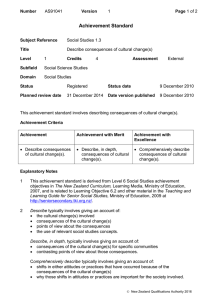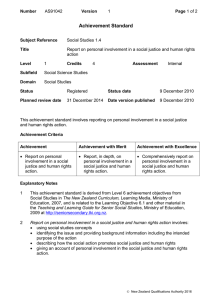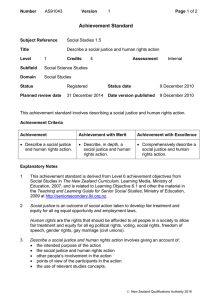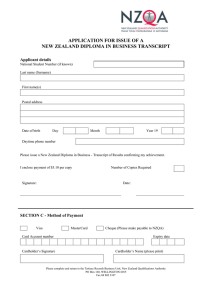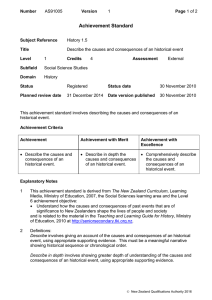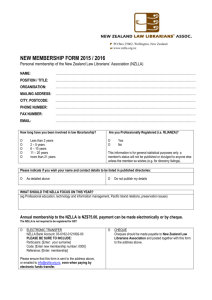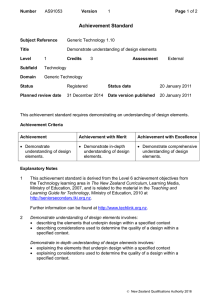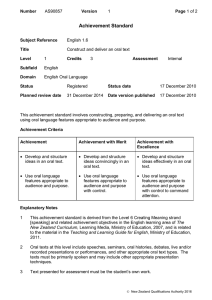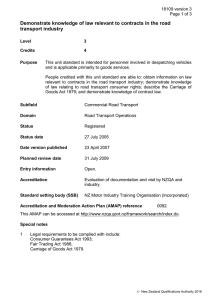Write news stories from court proceedings for applied journalism
advertisement
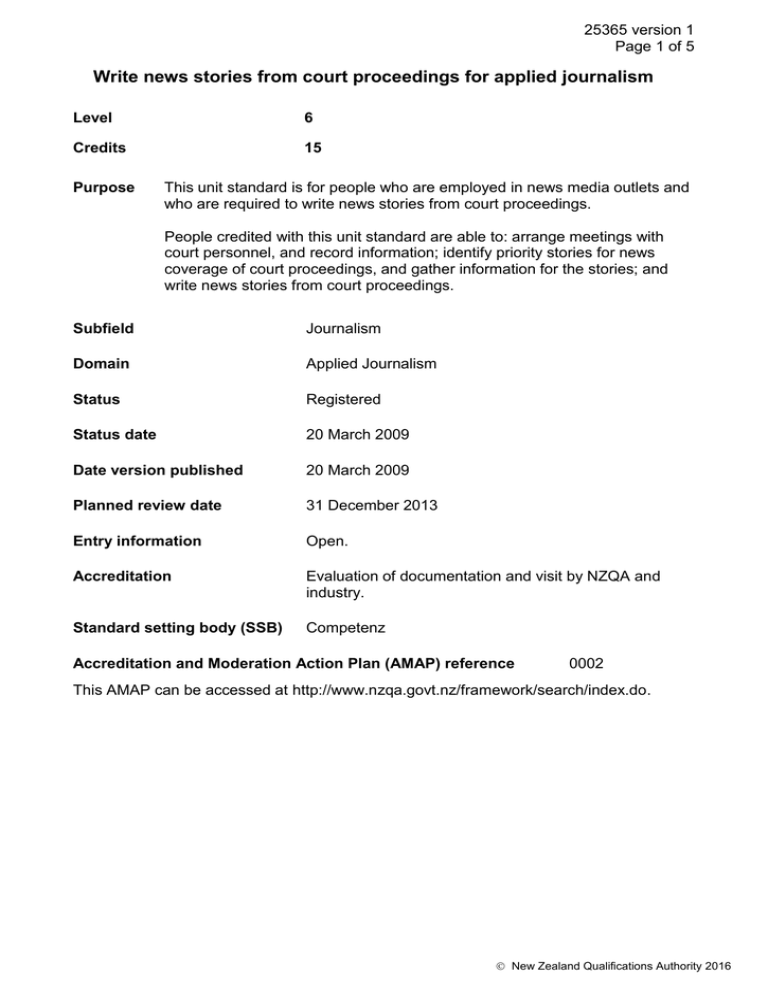
25365 version 1 Page 1 of 5 Write news stories from court proceedings for applied journalism Level 6 Credits 15 Purpose This unit standard is for people who are employed in news media outlets and who are required to write news stories from court proceedings. People credited with this unit standard are able to: arrange meetings with court personnel, and record information; identify priority stories for news coverage of court proceedings, and gather information for the stories; and write news stories from court proceedings. Subfield Journalism Domain Applied Journalism Status Registered Status date 20 March 2009 Date version published 20 March 2009 Planned review date 31 December 2013 Entry information Open. Accreditation Evaluation of documentation and visit by NZQA and industry. Standard setting body (SSB) Competenz Accreditation and Moderation Action Plan (AMAP) reference 0002 This AMAP can be accessed at http://www.nzqa.govt.nz/framework/search/index.do. New Zealand Qualifications Authority 2016 25365 version 1 Page 2 of 5 Special notes 1 Evidence presented for award of credit must be in accordance with the required standards for applied journalism, found in the current editions of: Statement of Principles (Wellington: New Zealand Press Council, 2006) available at http://www.presscouncil.org.nz/principles.html – for print journalism; Radio Code of Broadcasting Practice (Wellington: New Zealand Broadcasting Standards Authority, July 2008) available at http://www.bsa.govt.nz/codesstandards-radio.php – for radio mode; Pay Television Code of Broadcasting Practice (Wellington: New Zealand Broadcasting Standards Authority, January 2008) available at http://www.bsa.govt.nz/codesstandards-paytv.php; and the Free-to-Air Television Code of Broadcasting Practice (Wellington: New Zealand Broadcasting Standards Authority, August 2006) available at http://www.bsa.govt.nz/codesstandardsfreetv.php. 2 Relevant texts may include but are not limited to: Burrows, John, A Journalist's Guide to the Law (Wellington: New Zealand Journalists Training Organisation, Wellington, 5th ed, 2006); Burrows, John, and Cheer, Ursula, Media Law in NZ, (South Melbourne: Oxford University Press, 5th ed, 2005); Ministry of Justice, Media Guide for Reporting the Courts (Wellington: Ministry of Justice, October 2008); Price, Steven, Media Minefield: A journalist’s guide to media regulation in New Zealand (Wellington: New Zealand Journalists Training Organisation, 2007); Tully, Jim (ed), Intro: A beginner's guide to professional news journalism (Wellington: New Zealand Journalists Training Organisation, 4th edition, revised 2008). This publication can be obtained from the NZJTO website www.journalismtraining.co.nz, under the Bookshop section. 3 Relevant legislation: Care of Children Act 2004; Children, Young Persons, and Their Families Act 1989; Coroners Act 2006; Crimes Act 1961; Criminal Justice Act 1985; New Zealand Bill of Rights Act 1990; Official Information Act 1982; Resource Management Amendment Act 1996. 4 This unit standard has been designed for learning and assessment in the workplace. For assessment against this unit standard candidates will submit a portfolio of five news stories, which represent a range of cases heard. The stories will have been developed and written by the candidate from information gathered using skills learned during their workplace training. The stories submitted will have been completed within times set by the news media outlet, and will have been published or broadcast on radio or television. New Zealand Qualifications Authority 2016 25365 version 1 Page 3 of 5 5 Definitions broadcast refers to broadcast on television or radio depending on the activities of the workplace; industry standards refers to the required standards for applied journalism and the industry texts and sources cited in the special notes as well as documented policies and procedures set down by the workplace; publication refers to publication in newspapers, magazines, or periodicals, depending on the activities of the workplace. Elements and performance criteria Element 1 Arrange meetings with court personnel, and record information. Performance criteria 1.1 Introductory meetings with court personnel are arranged, and information resulting from the meetings is recorded in accordance with industry standards. Range evidence is required for a minimum of four meetings with different personnel; personnel may include but are not limited to – justices, associate justices of the high court, district court judges, juries, counsel, registrar, probation officers, coroners, bailiffs, victims, justices of the peace, police prosecutors. Element 2 Identify priority stories for news coverage of court proceedings, and gather information for the stories. Performance criteria 2.1 The court list is accessed using the workplace court diary system, and information from the list is used to identify priority cases for reporting, in accordance with industry standards. 2.2 List of priority cases is justified and approved in accordance with industry standards. 2.3 Information relevant to court proceedings for priority cases is obtained from court documents and personnel. Range documents and personnel may include but are not limited to – registrar, prosecutor, defence counsel, charge sheet, court register, prosecutor's summary. New Zealand Qualifications Authority 2016 25365 version 1 Page 4 of 5 2.4 Applications are made, in accordance with industry standards, for reporting on court proceedings on identified priority cases. Range 2.5 applications may include but are not limited to applications for – filming, photographing or recording during court proceedings; official information from the Official Information Act; name suppression. Backgrounders and/or issues arising from identified priority stories are identified, and information is gathered for use in follow-up stories. Element 3 Write news stories from court proceedings, in accordance with industry standards. Range essential information, where available, in each story includes, but is not limited to – news angles; supporting information; defendant details; charge; plea; evidence; verdict; sentence; mitigation pleas; judge's comments; name of the court; name of the judge; name of the prosecutor; name of the defence counsel; date, time and place of hearing; statements by defence and prosecution; evidence from witnesses. Performance criteria 3.1 News stories comply with the requirements of court orders. Range court orders include – suppression of information, contempt of court rules, injunction. 3.2 News stories meet editorial requirements for publication or broadcast. 3.3 News stories are written in accordance with media law requirements. Please note Providers must be accredited by NZQA, or an inter-institutional body with delegated authority for quality assurance, before they can report credits from assessment against unit standards or deliver courses of study leading to that assessment. Industry Training Organisations must be accredited by NZQA before they can register credits from assessment against unit standards. Accredited providers and Industry Training Organisations assessing against unit standards must engage with the moderation system that applies to those standards. Accreditation requirements and an outline of the moderation system that applies to this standard are outlined in the Accreditation and Moderation Action Plan (AMAP). The AMAP also includes useful information about special requirements for organisations wishing to develop education and training programmes, such as minimum qualifications for tutors and assessors, and special resource requirements. New Zealand Qualifications Authority 2016 25365 version 1 Page 5 of 5 Comments on this unit standard Please contact Competenz info@competenz.org.nz if you wish to suggest changes to the content of this unit standard. New Zealand Qualifications Authority 2016
